As computing hardware continues to advance at a staggering pace, the latest innovation making waves in the industry is the introduction of DDR5-9600 memory, specifically known as Clocked Unbuffered DIMM (CUDIMM). This cutting-edge technology is being spearheaded by Chinese memory manufacturers and is slated to debut alongside Intel’s upcoming Arrow Lake platform. The announcement signals a significant milestone in memory technology, characterized by unprecedented speed and technical enhancements.
Unparalleled Speed and Performance
Breaking New Ground in Memory Speeds
The DDR5-9600 CUDIMM modules offer groundbreaking speeds ranging from 8,000 MT/s to an impressive 10,000 MT/s. This development positions Intel at the forefront of memory technology for desktop platforms, outstripping rival AMD, whose latest X870 motherboards provide DDR5-8000 MT/s through overclocking. The substantial speed increase not only promises to enhance overall system performance but also marks a significant leap in memory technology, with potential applications in gaming, data-intensive tasks, and enterprise environments.
Crucially, CUDIMMs incorporate a clock generator directly onto the printed circuit board (PCB), a design choice that improves signal integrity and stability, enabling these higher frequencies. This is a pivotal advancement compared to current DDR5 memory modules, which rely on external clocking mechanisms and face limitations in achieving such high speeds. The built-in clock generator is particularly effective at maintaining stability and signal clarity, even under stringent operational conditions, making DDR5-9600 CUDIMMs a robust solution for power users and professionals alike.
Technical Enhancements and Superior Stability
The incorporation of a clock generator onto the PCB of CUDIMM modules is not merely a marginal enhancement but a transformative upgrade. This design innovation mitigates the degradation of signal integrity that plagues earlier memory technologies. By addressing this critical issue, DDR5-9600 achieves a harmonious balance between speed and stability, ensuring that high frequencies are maintained without compromising system reliability. This balance is essential for users who run demanding applications that require consistent and fast memory access.
Furthermore, this enhancement makes CUDIMM uniquely suited for Intel’s platform, as it leverages Intel’s Extreme Memory Profile (XMP) for overclocking. Unlike conventional DDR5 modules that may struggle with maintaining stability at higher speeds, CUDIMM modules are engineered to handle these challenges adeptly. This exclusive compatibility with Intel platforms also forms part of Intel’s broader strategy to provide a differentiated performance advantage. However, it excludes AMD EXPO support, marking a substantial divide in memory performance capabilities between Intel and AMD desktop platforms.
Strategic Implications for Intel and AMD
Intel’s Competitive Edge
Intel’s integration of CUDIMM technology with the Arrow Lake platform represents a strategic maneuver to regain competitive ground over AMD. By offering memory speeds that are visibly superior to AMD’s, Intel aims to attract not only enthusiasts and gamers but also enterprise users who demand unparalleled performance. This move is likely to fortify Intel’s market position at a crucial time when memory speed is becoming a key differentiating factor in consumer choice and hardware capability.
The exclusive nature of CUDIMM compatibility with Intel’s XMP profiles means that users seeking the maximum memory speeds will have to opt for Intel platforms. This exclusivity is expected to drive demand for Intel’s Arrow Lake CPUs, as early adopters and performance-focused consumers will be keen to capitalize on the superior memory technology. In turn, this could catalyze broader industry adoption of CUDIMM modules, as more manufacturers and mainstream brands consider entering the high-speed memory market.
AMD’s Response and Future Prospects
With computing hardware advancing rapidly, the latest industry sensation is the launch of DDR5-9600 memory, specifically known as Clocked Unbuffered DIMM (CUDIMM). This revolutionary technology is being led by Chinese memory manufacturers and is expected to debut in tandem with Intel’s forthcoming Arrow Lake platform. This development marks a significant leap in memory technology, promising record-breaking speeds and technical advancements.
What sets DDR5-9600 memory apart is its extraordinary speed and efficiency, potentially transforming various computing applications, from gaming to high-performance computing tasks, by providing faster data access and improved overall performance. The partnership between Chinese memory companies and Intel highlights a growing global collaboration in the technology sector, aiming to push the boundaries of what’s possible with modern hardware.
The introduction of DDR5-9600 memory is not just an incremental upgrade but a breakthrough that could shape the future of computing. By setting new standards for speed and performance, this technology is poised to meet the increasing demands of today’s data-intensive applications. The Arrow Lake platform, combined with DDR5-9600, represents a harmonious blend of cutting-edge hardware designed to deliver unparalleled computing experiences.

